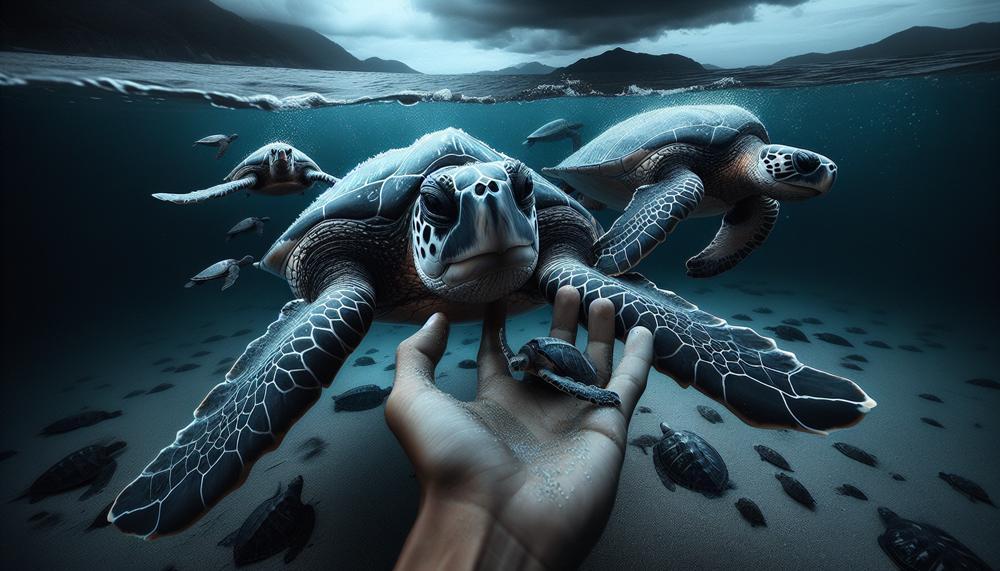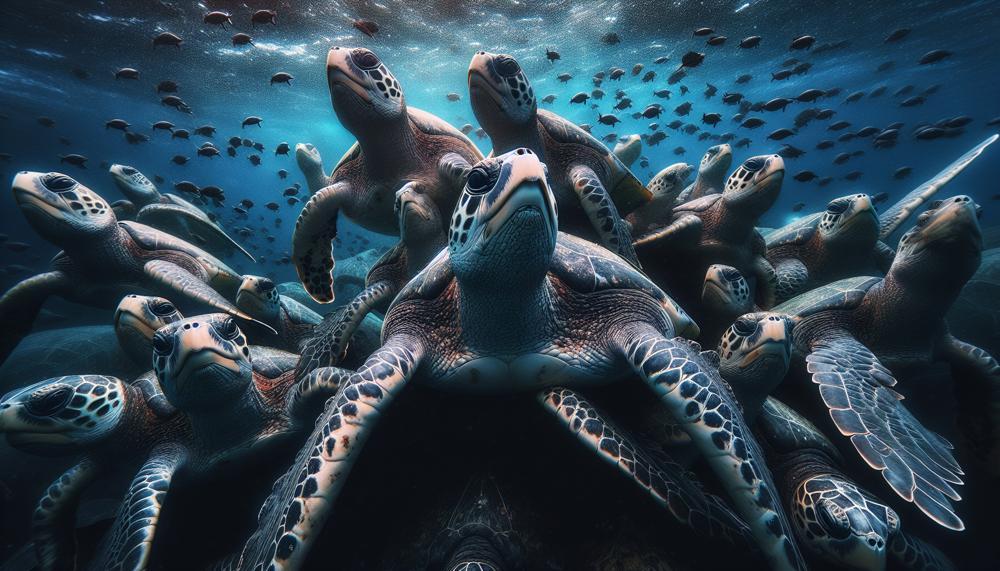For over 100 million years, the leatherback sea turtles have been silently gliding through the vast oceans, their majestic presence a symbol of resilience and survival. But now, these gentle giants are facing a critical threat – endangerment.
As an avid animal lover and environmental advocate, it deeply saddens me to see such a vital species on the brink of extinction.
But what exactly is causing this decline in leatherback sea turtle populations? Let’s delve into some key reasons:
- Climate change: The rising temperatures and changing ocean currents have disrupted the nesting sites and food sources of these magnificent creatures.
- Human interference: Pollution, fishing nets, and plastic waste pose a significant danger to the well-being of leatherbacks.
- Egg poaching: The demand for turtle eggs in certain cultures has led to illegal harvesting and destruction of nesting sites.
- Habitat loss: Coastal development and beach erosion have greatly reduced suitable nesting areas for leatherback sea turtles.
It is imperative that we address these issues before it’s too late. These ancient creatures play a crucial role in maintaining the balance of our oceans, and their disappearance would have catastrophic consequences.

So let’s raise awareness and take action to protect these magnificent animals for generations to come.
Together, we can make a difference and ensure that the giants of the sea continue to grace our oceans with their presence.
Contents
- 1 Why Are Leatherback Sea Turtles Endangered?
- 2 The Impact of Human Activities on Leatherback Sea Turtles
- 3 Fishing Gear and Accidental Capture: A Major Threat to Leatherback Sea Turtles
- 4 Habitat Loss and Its Consequences for Leatherback Sea Turtles
- 5 The Effects of Climate Change on Turtle Nesting Grounds
- 6 Plastic Pollution: A Deadly Danger for Leatherback Sea Turtles
- 7 Illegal Poaching and Trade: A Significant Factor in the Decline of Leatherback Sea Turtle Populations
- 8 Conclusion
Why Are Leatherback Sea Turtles Endangered?
The endangerment of leatherback sea turtles is heavily influenced by several major factors. These include bycatch in fisheries, the illegal collection of eggs and killing of adult turtles, coastal development, pollution, marine debris, climate change, loss of nesting habitats, and plastic pollution in the ocean. Each of these factors has played a significant role in hindering the survival and reproduction of leatherback sea turtles, ultimately resulting in their current critical endangerment status.
- One major threat to the leatherback sea turtle population is bycatch in fisheries. This occurs when turtles become entangled in fishing gear or are caught as unintentional “bycatch” while targeting other species. This can be particularly harmful to leatherback sea turtles as they often become entangled in nets or hooked by longline fishing equipment, leading to injuries or death.
- In addition to bycatch, the illegal collection of eggs and killing of adult turtles for their meat and shells also poses a significant risk to the survival of leatherback sea turtles. Despite being illegal, this practice still occurs in many parts of the world, further contributing to the decline of these magnificent creatures.
- Coastal development has also had a major impact on leatherback sea turtles. As coastal areas are developed for tourism and industry, nesting habitats for these turtles are destroyed or degraded. This not only reduces the number of suitable nesting sites, but it also increases the risk of human-turtle interactions.
- Pollution and marine debris also pose a significant threat to leatherback sea turtles. Plastic pollution in particular is a major problem as turtles often mistake plastic bags and other debris for food, which can lead to injury or death.
- Another factor contributing to the endangerment of leatherback sea turtles is climate change. Rising temperatures can affect the sex ratio of hatchlings, leading to an imbalance in male and female populations. Additionally, changes in ocean currents and water temperatures can impact food availability for these turtles, further jeopardizing their survival.
The Impact of Human Activities on Leatherback Sea Turtles
The impact of human activities on leatherback sea turtles has been immense, leading to the critical endangerment of these majestic creatures.
Each activity has had a detrimental effect on their populations and habitats, causing them to decline rapidly.
Let’s take a closer look at how these activities have affected these turtles.
Coastal Development:
The development of resorts and homes along nesting beaches has resulted in the loss of vital nesting beach habitats for leatherback turtles. The bright lights from these developments can disorient hatchlings, causing them to stray from the ocean and become easy targets for predators.
In addition, the construction of barriers and driving vehicles on the beach can damage or destroy nesting sites, further reducing the available habitat for these turtles.
Increased Coastal Populations:
As coastal populations continue to grow, the number of people visiting and recreating on beaches also increases. This rise in human activity can disturb nesting turtles, causing them to abandon their nests or lay eggs in unsuitable areas.
Furthermore, vehicles on the beach can pose a threat to sea turtles by crushing nests or running over hatchlings.
Pollution:
Runoff and wastewater discharge pollute sea turtle habitats, making it challenging for them to survive.
This pollution can also directly harm the turtles by causing skin irritations, respiratory problems, or even death.
Watercraft Strikes:
Leatherback sea turtles are often struck by boats and other watercraft while feeding or migrating.
These collisions can result in severe injuries or even death for these turtles.
Climate Change:
The rising ocean temperatures due to climate change have multiple impacts on sea turtle populations.
Warmer temperatures can significantly alter the sex ratio of hatchlings, leading to a predominantly female population. It can also affect the availability of food sources for adult turtles.
Marine Debris:
Plastic bags and balloons closely resemble jellyfish, which is the primary food source for leatherback sea turtles.
When these turtles ingest plastic debris, it can cause blockages in their digestive systems, ultimately leading to starvation or death.
Fishing Gear and Accidental Capture: A Major Threat to Leatherback Sea Turtles
Leatherback sea turtles are frequently caught accidentally by various types of fishing gear, including longlines, gillnets, traps and pots, trawls, and purse seines. These unintended captures pose a significant threat to the already endangered status of the species, causing direct mortality and hindering the population’s ability to bounce back.
Furthermore, the accidental capture of leatherback sea turtles has a ripple effect on marine ecosystems as these creatures play a crucial role in maintaining the natural balance.
The most commonly used fishing gear that accidentally captures leatherback sea turtles is longlines, which stretch for miles and can catch numerous marine animals at once. Gillnets, also known as “walls of death,” are another major threat to these turtles as they can easily become entangled and drown. Traps and pots, often used to catch crustaceans, can also inadvertently trap leatherback sea turtles, leading to their death. Additionally, trawls and purse seines, large nets pulled through the water to catch schools of fish, can also catch and harm these gentle creatures.
The accidental capture of leatherback sea turtles has a profound impact not only on the species itself but also on the marine ecosystem as a whole.
These turtles are crucial for maintaining the natural balance of their habitat by controlling jellyfish populations. With fewer leatherback sea turtles in the ocean due to accidental capture, jellyfish populations can grow unchecked, disrupting the food chain and negatively affecting other marine species.
Habitat Loss and Its Consequences for Leatherback Sea Turtles
Leatherback sea turtles are facing the danger of extinction, mainly due to the loss of their natural habitats. These ancient creatures have been roaming the earth for over 100 million years, but their numbers have decreased dramatically in recent times due to human actions.
These sea turtles rely heavily on specific habitats for nesting, feeding, and migration, and any changes or damage to these habitats can have devastating consequences on their survival.
- One of the main contributors to habitat loss for leatherback sea turtles is coastal development. The process of dredging, which involves removing sediment from the ocean floor, can lead to sedimentation in the water, making it hard for these turtles to navigate or find food. Additionally, coastal development often leads to pollution and littering on the beaches, which can harm and even suffocate these gentle creatures.
- Climate change is another critical factor in the loss of habitats for leatherback sea turtles. As temperatures continue to rise, sea levels also increase, causing flooding and erosion on nesting beaches. This not only affects their breeding sites but also disrupts other aspects of their life cycle. For instance, with rising temperatures, there is a risk of imbalances in the sex ratio of hatchlings, which can have a significant impact on the population.
- Moreover, coastal development has also resulted in the degradation of nesting beaches through erosion, pollution, and artificial lighting. Leatherback sea turtles are known for their long migrations, with females traveling thousands of miles back to the same beaches where they were born to lay their eggs. However, artificial lighting from buildings and homes can disorient hatchlings, leading them towards land instead of the ocean where they have a better chance of survival.
- Furthermore, fishing and ocean pollution are other human activities that greatly contribute to habitat loss for leatherback sea turtles. These marine creatures often get entangled in fishing gear or ingest plastic and other pollutants, causing harm or even death. This not only directly impacts their survival but also has a detrimental effect on the health of their habitats.
The Effects of Climate Change on Turtle Nesting Grounds
Climate change has proven to be a significant threat to the survival of leatherback sea turtles, as it greatly affects their nesting grounds. The rising sea levels and intensifying storms have resulted in the destruction of their nesting sites, leaving them with few safe places to lay their eggs.
Furthermore, changes in temperature and ocean currents have had a profound impact on the food sources of these turtles, leading to an imbalance in their diet and affecting their overall health.
Additionally, climate change has also affected the sex ratio of hatchlings, with warmer temperatures resulting in more female offspring. This poses a risk to the population of leatherback sea turtles as it can lead to an imbalance in gender distribution, making it difficult for them to reproduce and maintain a healthy population.
It is essential to take urgent action against climate change to protect these ancient creatures. This includes reducing our carbon footprint, implementing sustainable practices, and preserving their nesting sites.
Plastic Pollution: A Deadly Danger for Leatherback Sea Turtles
Plastic pollution has a significant and direct impact on the population of leatherback sea turtles. These magnificent creatures often mistake plastic debris for their natural food sources, leading to ingestion and potentially life-threatening health issues.
Additionally, the threat of entanglement poses a serious danger to these turtles. Furthermore, the degradation of their nesting habitats due to plastic pollution indirectly affects their survival and well-being. It is crucial that immediate and urgent action is taken to address this pressing issue and protect the leatherback sea turtles from further endangerment.
In fact, I have personally witnessed the devastating effects of plastic pollution on these majestic creatures. During one of my trips to the beach, I came across a leatherback sea turtle struggling to free itself from a plastic bag that had become entangled around its flippers.
It was a heart-wrenching sight, and it made me realize the severity of the problem. This experience inspired me to take action and make a difference in any way I could.
Illegal Poaching and Trade: A Significant Factor in the Decline of Leatherback Sea Turtle Populations
Illegal poaching and trade pose a grave threat to the survival of leatherback sea turtles. These majestic creatures are highly coveted for their meat, eggs, shells, and other body parts, which are used in traditional medicine and decorative industries.
Despite existing laws and regulations in place to protect these endangered turtles, the demand for their products continues to drive widespread poaching and illegal trade.
| Effects on Leatherback Sea Turtles | Causes of Poaching and Trade | Efforts to Combat Poaching and Trade |
| – Direct killing of adult turtles for their meat and eggs – Destruction of nesting sites for commercial development – Capture for the pet trade – Accidental catch in fishing gear |
– High demand for leatherback sea turtle products in traditional medicine and decorative industries – Poverty and lack of alternative livelihoods – Lack of effective law enforcement and corruption |
– Strict enforcement of laws and regulations protecting sea turtles – Collaboration with local communities to provide alternative livelihoods – Education and awareness initiatives about the importance of conserving sea turtles |
Not only does illegal poaching and trade directly harm leatherback sea turtles, but it also indirectly affects their survival by disrupting their nesting habitats. Poachers often destroy or damage nesting beaches, making it difficult for turtles to successfully lay their eggs. This leads to a decrease in the number of viable nests and hatching success rates.
Moreover, poaching and trade target female turtles during nesting season when they are most vulnerable.
This greatly impacts the reproductive success of the species, as each female turtle can lay hundreds of eggs in a single nesting season.
Also Read: What Diseases Do Turtles Carry?
Conclusion
In conclusion, the endangerment of leatherback sea turtles is a direct result of our actions.
Climate change, pollution, coastal development, and illegal poaching and trade are all contributing factors to their decline. These magnificent creatures are facing numerous threats to their survival, including habitat destruction, entanglement in fishing gear, and ingestion of plastic waste.
By raising awareness and implementing sustainable practices, we can ensure that future generations will have the opportunity to witness the graceful movements of these gentle giants in our vast oceans.






